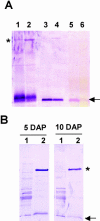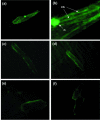An invertase inhibitor from maize localizes to the embryo surrounding region during early kernel development
- PMID: 14657403
- PMCID: PMC316304
- DOI: 10.1104/pp.103.027466
An invertase inhibitor from maize localizes to the embryo surrounding region during early kernel development
Abstract
Invertase activity is thought to play a regulatory role during early kernel development by converting sucrose originating from source leaves into hexoses to support cell division in the endosperm and embryo. Invertases are regulated at the posttranslational level by small protein inhibitors, INVINHs. We found that in maize (Zea mays), an invertase inhibitor homolog (ZM-INVINH1) is expressed early in kernel development, between 4 and 7 d after pollination. Invertase activity is reduced in vitro in the presence of recombinant ZM-INVINH1, and inhibition is attenuated by pre-incubation with sucrose. The presence of a putative signal peptide, fractionation experiments, and ZM-INVINH1::green fluorescent protein fusion experiments indicate that the protein is exported to the apoplast. Moreover, association of ZM-INVINH1 with the glycoprotein fraction by concanavalin A chromatogaphy suggests that ZM-INVINH1 interacts with an apoplastic invertase during early kernel development. ZM-INVINH1 was localized to the embryo surrounding region by in situ analysis, suggesting that this region forms a boundary, compartmentalizing apoplast invertase activity to allow different embryo and endosperm developmental rates.
Figures







References
-
- Benello J-F, Opsahl-Ferstad H-G, Perez P, Dumas C, Rogowsky PM (2000) Esr genes show different levels of expression in the same region of maize endosperm. Gene 246: 219-227 - PubMed
-
- Bommert P, Werr W (2001) Gene expression patterns in the maize caryopsis: clues to decisions in embryo and endosperm development. Gene 271: 131-142 - PubMed
-
- Brand U, Simon R (2000) Dependence of stem cell fate in Arabidopsis on a feedback loop regulated by CLV3 activity. Science 289: 617-619 - PubMed
-
- Camardella L, Carrotore V, Ciardiello MA, Servillo L, Balestrieri C, Giovane A (2000) Kiwi protein inhibitor of pectin methylesterase amino-acid sequence and structural importance of two disulfide bridges. Eur J Biochem 267: 4561-4565 - PubMed
MeSH terms
Substances
LinkOut - more resources
Full Text Sources
Other Literature Sources

